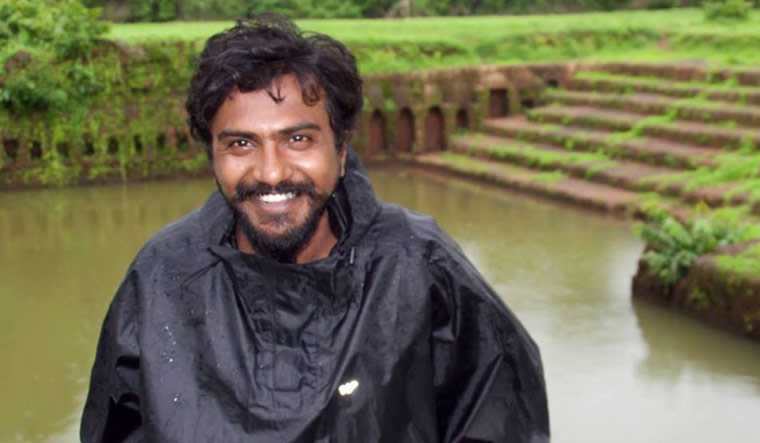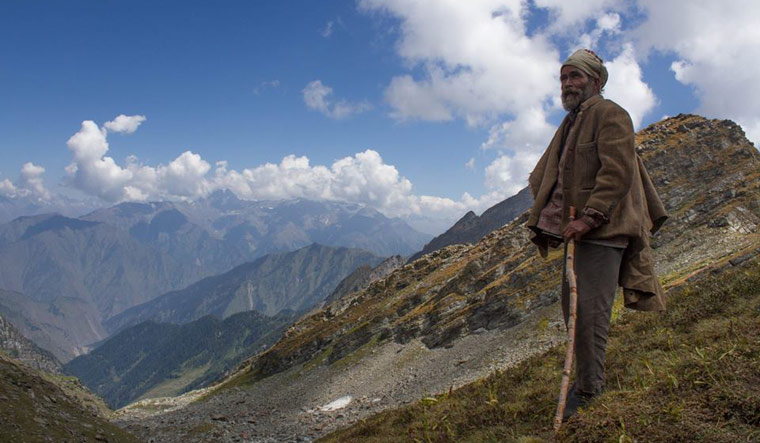During a routine technical check before the screening of his film, The Gold-Laden Sheep and the Sacred Mountain, at the Mumbai Film Festival, director Ridham Janve realised there was something wrong with the projection. The visuals appeared darker than what he had originally created. This was during the third screening of the film at the recently concluded festival.
Janve, a 2011-graduate from the National Institute of Design, who gradually veered towards filmmaking, had only two options: to cancel the screening or go ahead with it as it is. He did not consider the first option at all, neither did he want to go ahead with the second option. Rather, he improvised—he reduced the temperature in the auditorium to an extent where it became slightly chilly to add an effect and elevate experience of the audience as they watched his Gaddi-dialect movie, set in the Chambal and Kangra hills of Himachal Pradesh.
Improvisation has been his mantra even during the making of the movie. Shooting in the hills came with its own challenges. There were some genuine problems, the most prominent being lack of resources like electricity to charge electronic devices. Carrying a generator to the high altitudes did not make sense because it would have come with its own cost and challenges. So, he turned to solar power. And then it rained, and the shoot had to be halted.
At the centre of the film is an elderly shepherd Arjun (Bhedpal Arjun Pant) and his Nepali assistant (Lokendra Gurung). As much as the film is about the life of these two on the hills, focusing on their daily drill of taking the sheep and goats to graze and their banter, it also captures the folklore of the area. There is a plane crash in the region, followed by speculations of what may have happened to the people and the rumoured gold and silver the plane was loaded with. And then begins Arjun's adventurous journey.
It was important for Janve to cast people from the area to bring out the simplistic elements in the story. While Lokendra, who organises trips in the area, was an easy find, it took him days to find the perfect person to fit the role of the shepherd Arjun. He had met almost every shepherd in the region, but could not find that one person in which he could see his character. “The pastures where they take the herds to graze is up the hill, it is quite daunting to climb those. Plus, most of these places are a day apart from each other. Every time we decided that we need to go looking for a shepherd, it meant organising an extensive trek. There were times, we returned from half the way to the village,” says Janve, who had met almost all the shepherds in the region except one.
Finally, at the 'nag taal', a famous sacred spot atop the mountain, he saw someone standing across the lake. “It was extremely quiet and meditative that day,” he recalls. He realised that could be the shepherd he had not met. The man told him, “Whatever you are here for, I am there for you.” It was magical, Janve confesses, sitting at a café in the western suburbs of Mumbai along with his lead actors as they narrate the story from their point of view.
 Director Ridham Janve | via Facebook
Director Ridham Janve | via Facebook
It was challenging to work with non-actors. But he could not imagine these characters being played by actors from elsewhere. “We wanted to retain the sense of the mountain and its people who are completely devoted to the mountains,” he says. Since these non-actors were completely unaware of how a camera works, there would be times during the shoot that the actors started talking to each other, giving them instructions. “The spontaneity of the actors, at times, worked in the film's advantage,” says Janve.
The director did not know the Gaddi dialect either. It was only because of familiarity to the area because he had done many treks earlier that he understood the language pretty well. “The genesis of the film happened long back when my friend, Akshay (also the writer of the film) and I were writing something totally different and looking for cheap places to stay. That is when we started going to the Gaddi villages, not ever thinking about making a film or about the people there. But we indulged in their stories and anecdotal information about their culture,” Janve recalled in the question-answer session with the audience after the screening.
During one of these treks, the two friends thought that a film could be made on the life of the Gaddis. They took two days to write a layout for the film. It was not a script, he says. But a treatment note of sorts. “We kept the script open because we wanted to be open as we shot the film.”
The first cut of the film was finished in 2016, after which it became a part of the NFDC’s Work In Progress Lab. “The film was seen by some very prominent people there. They shared their experiences and suggestions with us, some of which we incorporated in the film. It was very beneficial because we got noticed. Prior to that, we had no idea who is going to watch the film. We just wanted to be free while making it with no pressure of a narrative or pace, or having to make it interesting. We didn’t want to make any gimmicks in the film, we just wanted to stay true to what mountains are,” he says.
He then quotes Werner Herzog, “Walk on foot, learn languages and a craft or trade that has nothing to do with cinema. Filmmaking — like great literature — must have experience of life at its foundation.” The films of Werner Herzog, he says, have had a great influence on him as far as filmmaking style is concerned. “And while we were attempting to make the film, his words were resonating,” says Janve who is originally from Rajasthan and now lives in Goa.
Janve, as he takes The Gold-Laden Sheep and the Sacred Mountain to film festivals, is still discovering his language of filmmaking by venturing into new genres and forms. One of his next projects would be set in his home state, Rajasthan, close to Udaipur. “It is a psychological thriller, again with a lot of local people acting in it. But along with a few trained actors, too, this time,” he says.



